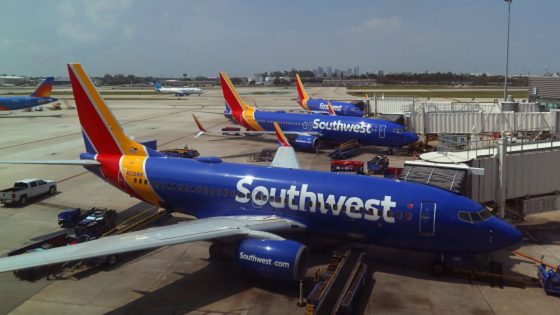Southwest Airlines on Thursday forecast a potential drop in unit revenue for the third quarter as an oversupplied U.S. market has forced airlines to discount tickets during what is usually the most lucrative period of the year.
Southwest said unit revenue for the current quarter could fall as much as 2% over last year and nonfuel costs could rise as much as 13%, with higher expenses weighing on the airline through the end of 2024.
Here is how Southwest performed in the second quarter compared with Wall Street expectations, according to consensus estimates from LSEG:
- Earnings per share: 58 cents adjusted vs. an expected 51 cents
- Revenue:Â $7.35 billion vs. $7.32 billion expected
The Dallas-based airline said its second-quarter revenue rose 4.5% from last year to $7.35 billion, a record, but its profit dropped more than 46% to $367 million, or 58 cents a share. Revenue per available seat mile, a gauge of airline pricing power, fell 3.8%, roughly in line with the carrier’s reduced forecast last month.
Southwest reported adjusted per-share earnings of 58 cents a share, above analysts’ expectations.
“Our second quarter performance was impacted by both external and internal factors and fell short of what we believe we are capable of delivering,” CEO Bob Jordan said in an earnings release.
Southwest said Thursday that it is in talks for compensation from Boeing as its sole supplier of airplanes struggles to deliver aircraft on time because of its safety and manufacturing crises. Southwest said it continues to expect just 20 deliveries from Boeing this year â less than half of what it had previously forecast.
The airline is in the middle of an overhaul as pressure mounts from investors to do more to increase revenue. Elliott Investment Management disclosed a nearly $2 billion stake in the carrier last month and called for a leadership change.
Earlier Thursday, Southwest announced that it will do away with its open seating plan and offer some seats on its Boeing aircraft that have extra legroom and add overnight flights, the biggest changes to its business model in its more than five decades of flying. The changes, which start next year, would make Southwest more like its network carrier rivals.
“We are taking urgent and deliberate steps to mitigate near-term revenue challenges and implement longer-term transformational initiatives that are designed to drive meaningful top and bottom-line growth,” Jordan said in the release.
Delta Air Lines and United Airlines executives earlier this month said they expect to see U.S. capacity begin to moderate in August, which could lead to higher fares.
Source Agencies



